Knights with long lions and wings at their sides are a proud page in the history of the Polish army. But they were not the only ones - in the history of our country there was no shortage of deadly and well-trained soldiers, ready to shed their blood for their homeland. Here are the best of the best - the true elite of the Polish army.
The Piast team
Mieszko I and Bolesław the Brave would not have made their conquests if not for the brave princely team. Already during the reign of the first Polish ruler, the warriors were under his special care - he provided them with food and shelter, and in return he expected absolute loyalty.
What was their armament like? Piast warriors wore pointed, conical helmets, leather jackets studded with metal plates. They also had wooden round or almond shields. Only the wealthiest wore swords. Instead, typical weapons were spears, bows, axes, ice axes and hammers.
Arab traveler Ibrahim ibn Jakub recalled that Mieszko had:"3000 armored, divided into units, and a hundred of them means as much as ten hundred others ". Thanks to such valiant armed men, Mieszko was able to defeat even the rebellious Wichman in 967, and five years later to achieve a spectacular victory at the Battle of Cedynia.
Bolesław the Brave, who greatly enlarged his father's country, defeated the emperor of Germany and conquered Kyiv thanks to his troops. According to Gallus Anonymus, he had as many as 3,900 armored and 13,000 shield-bearers.
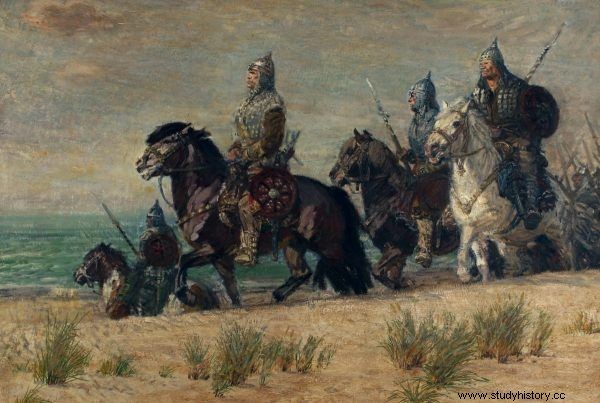
"Team Bolesławowa", a painting by Michał Bylina. Illustration from the book "Polish triumphs".
Medieval Knights
In the Middle Ages, when the chivalrous culture flourished in Western Europe, our knights also performed glorious deeds and wrote down on the pages of chronicles. The then law and custom required to appear on the battlefield on the call of the ruler with armament appropriate to the social position and financial possibilities. Apart from the steed, the most expensive piece of equipment was the weapon, hence the various types of weapons appeared on the battlefields.
At the beginning of the fourteenth century, swords intended for cutting dominated, but with time those with stabbing heads and koncerze began to gain popularity. Axes, pickaxes, spears and lances were also used. Reflex bows and crossbows were used for ranged combat. The most characteristic element of knightly equipment was armor . Less wealthy knights used chain mail, lamellar armor and brigantines, i.e. fabric vests with metal plates riveted from the inside. The richer ones could afford a cuirass covered with a fabric decorated with coats of arms.
Shields were used for defense - most often with the owner's coat of arms - initially triangular, later also quadrangular with a cutout for the back of the copy. Some chose rectangular transoms (larger footmen, smaller so-called transoms, riders).
One of the most famous Polish knights was, of course, Zawisza from Grabów, a participant in the Battle of Grunwald. Jagiełło's army defeated the Teutonic Knights there thanks to heavy armed Polish troops. Zawisza Czarny (apparently the knight's nickname came from his blackened armor) was known at European courts not only for his successes on the battlefields, but also for victories in many knight tournaments.
He took part in the tournament in Buda in Hungary, where the winner was awarded a horse with golden horseshoes. In 1415, in a tournament in Spain, threw the then famous knight John of Aragon from his saddle with one stroke of his lance , which confirmed his fame all over Europe.
Lisowczyki
In the times of the Polish Nobility, they carried destruction wherever they appeared. Lisowczyki - noble units "from the dirty work" - they spread terror in the 17th century.
The very principles of the operation of this army, in a way, provoked the later rapes, robberies and murders, for which - unfortunately - the Lisowians were famous. They were mercenaries, and their only reward was spoils of war. The formation by voting chose its own commander. Foreigners also served in their ranks - mainly Ruthenians and Lithuanians.
They were famous for their amazing riding skills and great speed of movement. They could cover up to 150 kilometers a day. Lisowczyk's clothes and weapons depended entirely on him - in this respect there was almost complete freedom. They mostly used the Eastern Tatar style of horse fighting and were incredibly cruel. Apparently, they had a habit of killing every passerby they met, so as not to leave any witnesses of their rapes and crimes.
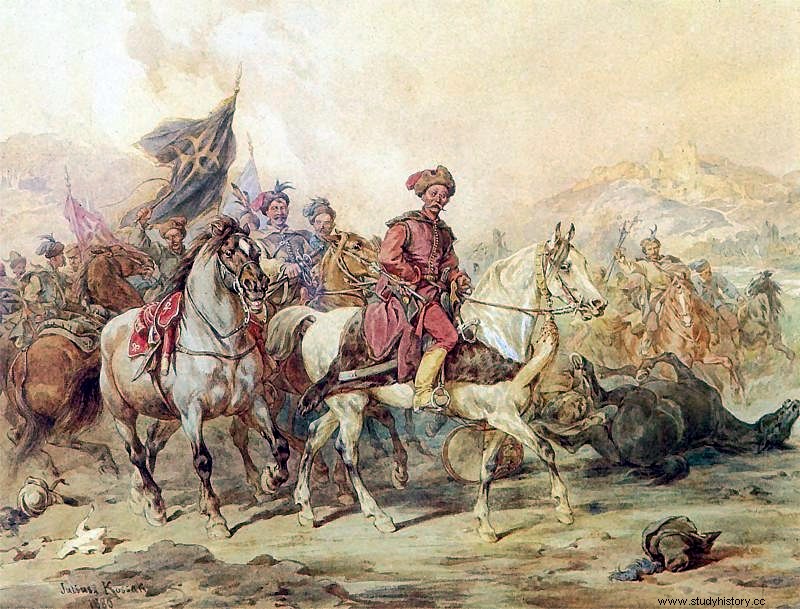
The foxes on Juliusz Kossak's watercolor.
The Russians, among others, were terrified of the Lisowczyk family. These troops wreaked havoc on their lands during the so-called Dimitriads - the armed interventions of the Republic of Poland in Russia during the reign of Sigismund III Vasa.
Panzer
Although they constituted the backbone of the army of the Polish-Lithuanian Commonwealth no less than the hussars, they are mentioned much less frequently. And usually it was the armored ones - after a breakthrough blow - the hussars circled and ultimately destroyed the enemy.
Typical elements of their attire and armament are chain armor with a hood or a helmet for the head, a round shield of Tatar origin (the so-called kalkan), a recurrent bow, saber, bandolets, an ice ax and a spear. Cavaliers took part in most of the battles that went down in history as the famous victories of Poles of that period.
For example, at Chocim, under the leadership of Hetman Jan Sobieski, as many as 11,000 of them fought. The armored attack during this legendary clash became the nail in the coffin for the Turkish troops . “Armored banners burst from behind the embankment, followed by Stanisław Jabłonowski with his hussars. (...) The Turks "rushed to the bridge, but soon they burdened it so much that it burst under the crowd of escapees, and those who were on it, having fallen into the water, cut the escape on the [s] obstruction" - describes Kacper Śledziński in " Polish triumphs ”.
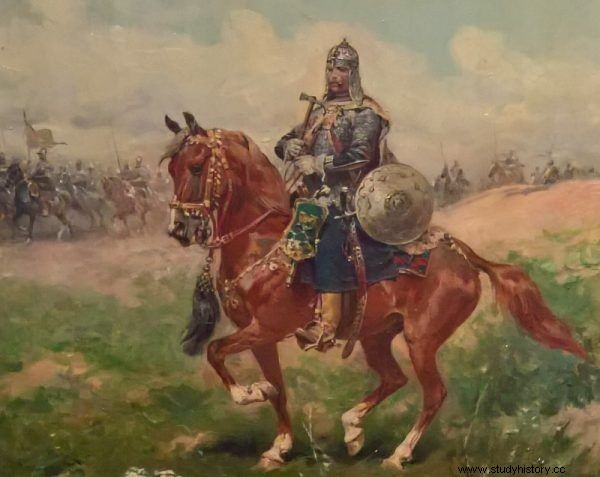
Armored companion in the painting by Józef Brandt.
Interestingly, according to the resolution of 1527, only the captain had to be noblemen. No nobility was required from "ordinary" cavalrymen, but only the best possible results in combat. Due to the fact that the maintenance of the armored vehicles was much cheaper than the costs generated by the hussars, already in the second half of the 17th century, they began to constitute the majority of Polish cavalry.
Cavaliers
Another formation that went down in history was the 1st Cavalry Regiment of the Imperial Guard fighting under Napoleon Bonaparte, created by the decree of the French ruler on April 6, 1807.
It was supposed to be an elite unit, composed entirely of volunteers (provided that they had the appropriate wealth and origin - a peasant could not become a light cavalryman). They fought in navy blue uniforms with amaranth collars, cuffs and lapels as well as caps over 20 centimeters high. Their armament included sabers as well as firearms:carbines and pistols . After a few years, they also received lances over two meters.
It is impossible not to write about their thrilling victory at the Somosierra Pass in Spain. Poles literally did the impossible there. The Spanish general Benito San Juan placed four batteries of guns in the 2.5 kilometer long and 8 meter narrow ravine. And that's not all! As Piotr Dróżdż lists in "Polish triumphs":
Moreover, in the hermitage standing about 400 meters in front of the buildings of the Somosierra settlement, shooting ranges for infantry were carved. (...) Spanish cannons made the gorge a truly hellish gate for attackers. Meanwhile, San Juan deployed roughly three thousand mostly irregular infantry on the gently sloping slopes of the valley. They were supposed to fire from behind numerous rock fragments located there.
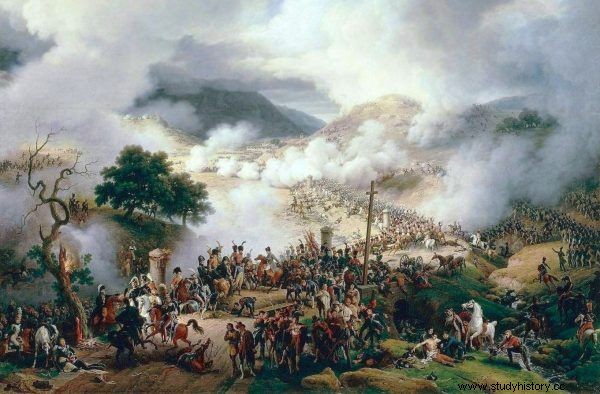
Battle of Somosierra in the painting by Louis François Lejeune.
The ravine seemed impregnable. It was then that Napoleon had to say:"leave it to the Poles" . And he was right. The cavalrymen set off on the enemy with full force, simply carrying the Spaniards. The 10-minute frenetic charge of the cannons was successful and opened the way for Bonaparte to Madrid.
Cavalry in the 20th century
Polish uhlans once again showed their power in the 20th century, it was also the last great victory of the cavalry. It is, of course, about the battle of Komarów during the Polish-Bolshevik war. On August 31, 1920, over 6,000 Cossacks from the Horse Army of Semyon Budyonny, rushing to help the Bolsheviks fighting near Warsaw, stood against 1,500 Polish lancers (1st Cavalry Division under the command of Colonel Juliusz Rómmel).
The possible addition of Konarmia Budyonny to the troops of Mikhail Tukhachevsky could be decisive for the entire war. However, this did not happen. First, the Soviet Cossacks were stopped by the tough defense of Zamość, and then, on the outskirts of the city, the four times smaller Polish cavalry literally defeated the enemy . The battle was murderous, lasting a total of 12 hours. The scales of victory tilted from one side to the other. Finally, one of the charges sealed the Poles' victory. "No wonder that after the war Rómmel described this charge as one of the most brilliant during the entire war" - emphasizes Sławomir Zagórski in "Polish triumphs".
Until the outbreak of World War II, cavalrymen were one of the members of the Polish Army. At the beginning of June 1939, about 28,000 horses served in the ranks of the Polish army. Their riders were equipped with the same equipment as other formations. Already during the September campaign, the soldiers fought mainly on foot. The infamous horse charges were rare, and animals were primarily used to move around and carry equipment (such as heavy rifles).
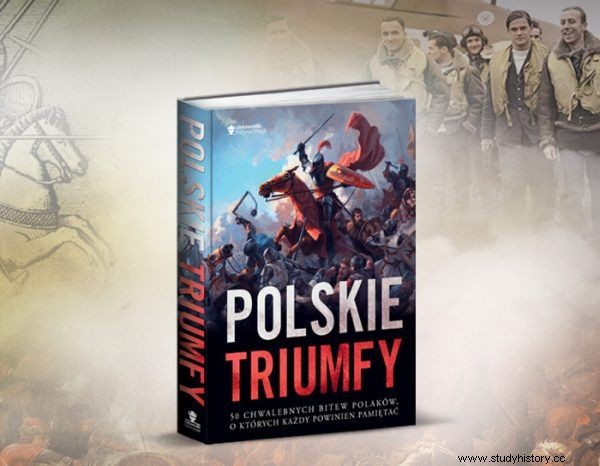
You can read about the victories of our weapon in our latest book "Polish triumphs" . It is the perfect gift for any history buff. They specialized in guerrilla operations:diversion, sabotage, counterintelligence and fighting behind enemy lines. The first drop, code-named "Adolphus", was carried out on the night of February 15/16, 1941. In total, over 80 such flights were organized. About 1/3 of the more than 300 Cichociemni who were transported to the country did not survive the war . Some of them used poison after being arrested by the Gestapo.
After the war, many continued to fight in the anti-communist underground, as did one of the most famous Steadfast Soldiers - Hieronim Dekutowski, aka Dam. After arrests by the Soviets, many Cichociemni were deported deep into Russia. Courts of the People's Republic of Poland carried out a death sentence on eight soldiers. The name of the branch was forbidden in People's Poland. Today, its tradition is cultivated, among others, by the special unit GROM them. Cichociemnych Paratroopers of the Home Army,
303 Squadron
The most famous air force in the history of the Polish military went down in history primarily with the daring defense of the British Isles during the Battle of Britain. The squadron was formed on August 2, 1940 under the Polish-British military agreement. It turned out to be the most effective air formation taking part in the battles with the Luftwaffe during the Nazi operation Seelöwe.
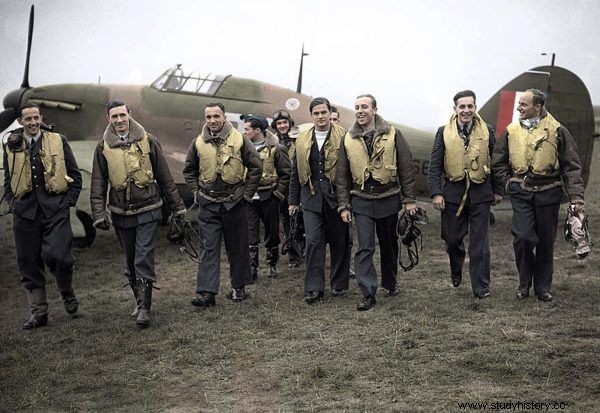
Squadron 303 pilots in the photo from 1940.
Polish pilots flew Hawker Hurricane Mk I fighters. It is true that they were worse than the German Messerschmitts Bf 109 E, but in the hands of Poles they turned out to be a deadly effective tool . Our compatriots made their debut in British skies at the end of August 1940. On the first day they knocked down six enemy machines. Soon their amazing abilities made them famous.
In total, the squadron knocked down 126 aircraft, which put it in first place among all air forces defending the British Isles. Today, some researchers consider this figure to be overestimated, but the fact that Poles turned out to be above-average airmen is not questioned. Even the Germans thought so. "General Adolf Galland, the German hero of the Battle of Britain, admitted that during the war the Germans got to know the Polish squadrons by order, and he himself ordered his young pilots to" fight like Poles "- writes Mateusz Drożdż in the chapter 303 devoted to the squadron" Polish triumphs ".
GROM
The GROM special unit, established in 1990, is one of the best units of this type in the world. It is compared to the American Delta Force branch. GROM members took part in operations almost in every corner of the globe.
The unit carried out its first foreign mission in 1994 - then soldiers as part of the "Uphold Democracy" operation went to Haiti. Later, it was used for military operations in the Balkans, the Persian Gulf and Afghanistan, among others.
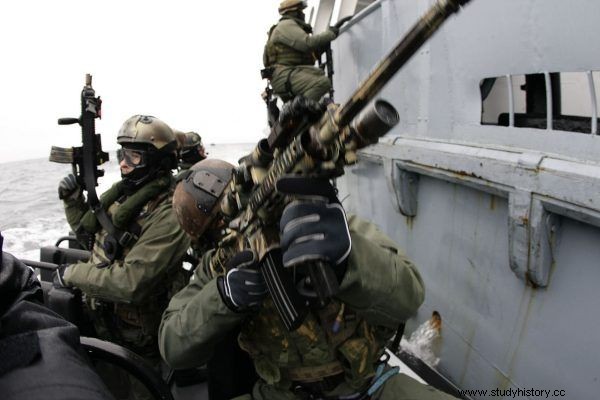
GROM and Navy_SEALs operators during joint exercises.
The most spectacular action of GROM men took place in 2003 during the Second War in Iraq. Polish commandos took control of the powerful KAAOT drilling platform. The facility was a real monster, 30 meters high and 1 kilometer long, containing 8 tanker cranes, as well as a four-story hotel. In addition, it was connected by a 300-meter truss with a second MABOT platform. The Poles managed to master it without their own losses.
Their current responsibilities include rescue and anti-terrorist missions, as well as combat missions. Their headgear stands out from other branches of the Polish Army. Like their predecessors from World War II - Cichociemni - modern commandos proudly wear gray berets.
***
You can read about the successes of our weapon in the book “Polish triumphs. 50 glorious battles in our history ” . Learn about the clashes that changed the course of history with this richly illustrated publication. From victorious battles in the times of Bolesław the Brave, to fierce battles in World War II. Successes that every Pole should remember. Buy today with a discount at empik.com ,
